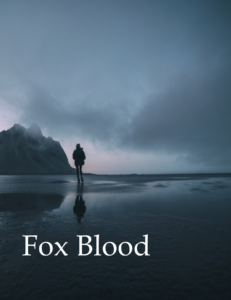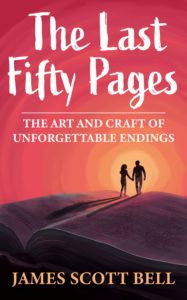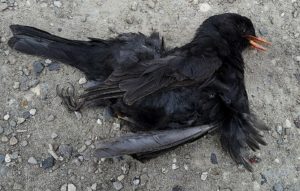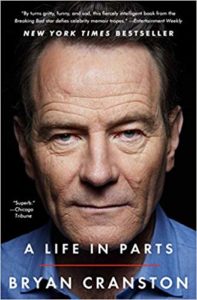
By PJ Parrish
I’ve been bingeing on all things British lately, so I was predisposed to like this tale. Plus, it appears to be about evil spirits to boot. I think…but I’m not sure. But that’s not the only issue. I also can’t tell what mood and tone the writer is going for here. And that, dear friends, is our dilemma, and lesson for the day.
Fox Blood and Family Anchors
Chapter 1
By the time she got home, Marte’s hands and feet ached with the cold, and her empty stomach was nauseated by the stink of the wharf. Her backpack clinked as she climbed the front steps. She’d found a few useful bits. Abalone shells, sea urchin spines, driftwood—the sort of trinkets the Life and Death folk could make use of but couldn’t get close enough to the water to gather for themselves.
In the early evening light, the ghostly chalk tracings of hexafoils—that surrounded the door frame and continued in paint across the threshold—seemed almost to glow. A comforting sign of protection. Turning her key in the lock, Marte leaned forward, set her shoulder to the swollen door and gave it a sharp bump. It squeaked inward slightly, showing only a crack of the familiar floorboards beyond. The damp Autumn nights were taking a toll on all the old houses.
She stepped up to have another crack, when gravity lurched away, the solidity of the door giving way beneath her as it was jerked open. From the hallway, came the hacksaw tone of her mother’s voice; “About bloody time!”
Off balance, Marte stumbled to the floorboards, swearing at the unexpected bolt of pain that ran up through her left knee and into her hip. Reaching up, she grasped the door handle to pull herself to her feet, trying her best to get a grip on the situation.
Her baby sister, Eve, was a squalling bundle in their mother’s arms, face red and rigid, as if about to implode, while their mum, Irena, was just as flushed, her usually pale skin mottled an ugly vermillion and white. Dressed to go out in the cold, she wore her pea-coloured coat, but both her temperature and mood were clearly on the rise. Irena’s fingers were gripped into tense claws behind Eve’s shoulders and she jiggled the baby painfully up and down, as though that might quieten the infant bleat somehow.
Treating herself to a deep breath and squaring off, Marte readied herself for the onslaught. “What’s going on?” she asked.
“I’m going to be late. Again!” Irena practically stamped her foot as she spoke.
Marte recoiled from the cool fleck of spit on her face. Months of pent-up frustration were bound up inside that one word and waiting to be let loose. Again. She fought the urge to look heavenward. “Okaaay…” they both heard the squeak of enamel as she gritted her teeth, barely containing it, her knuckles blanching as she throttled the door instead of something else. “And why is that my fault?”
___________________________
As we’ve often noted with our First Pagers, it’s hard to get your bearings as a reader in a mere 400 words. We lack the clues of cover art and back copy to ground us, so we critiquers often have to guess where we are, what year it is, and what genre we’re reading. All this said, you can still wrangle in readers with a well-written tease, even lacking context.
So what do we have here? Where are we? What era is it? I’m not sure. I’m guessing it’s England (“You’re bloody late!”), somewhere near the sea (Marte has gathered shells). What year is it? We get an enticing clue — hexafoils on the door. If you don’t know the term hexafoil, you’re not alone. I suspected it was an old marking of some kind but I had to look it up. Hexafoils are designs that appear in religious art and architecture (ie stained glass windows) but they are also medieval graffiti found in barns, churches, rural buildings, scratched in wood or stone to ward off evil spirits.
Way cool! I’m in. Love reading about darkly lit corners of British folklore. I’m an Anglophile, especially if it’s the old stuff. (Just got done watching Elizabeth and Lion in Winter again and am currently reading Minette Walter’s doorstop of a novel about the black plague, The Last Hours.
Problem is, with this submission are we in medieval England or present time? I can’t tell. The house is old, the door warped, but there is nothing else to tell us if this is 1769 or 2019. The proper names are vaguely old-fashioned sounding. Hexafoils (also called daisy wheels) are ancient but can still be seen everywhere in the England countryside. Marte is carrying a “backpack,” which is a modern word of American derivation. (as opposed to rucksack or knapsack). And when confronted by angry mother, she says, “Okaaaay,” which sounds like a petulant modern teen. So…we have confusion here, right off the bat.

old door with hexafoil carving
Which is a shame, because, like I said, I want to like this based on the small clues dropped about the daisy wheels and the mysterious Life and Death folk. I wanted to know more about them and why Marte was collecting trinkets for them.
But where does Marte go? Home — which needs a bit more description so we can tell where we are in time and space — and straight in the arms of a rather boring domestic scene. Yes, there is tension created when Mom begins to rag on Marte, but given the fact that Marte’s character is still a mere sketch so far, I didn’t care. My only emotion was to want to go back out that door as fast as possible.
I’m a bit at sea with this submission, because I am not sure what would make it stronger. And because there is some confusion about era and geography, I’m finding it hard to advise about a better way to begin this story. I can’t figure out what kind of person Marte is (even her age range) and why we, as readers, are being asked to enter her life at this particular point. Especially since the clues about evil spirits and Life and Death folk are far more interesting than a crabby mom and squalling baby.
Maybe the writer is trying to show us Marte’s “before” life so when something does happen to her — the “after” — we will be intrigued and care about her journey. But that, as James often points out, is a fatal mistake of many opening pages. Don’t show us the normal life and then up-end it. Get to the conflict and then you can go back and explain what happened.
Maybe you all can help me out here and be more articulate about this submission. It’s not bad, but there is something just off about it that I can’t quite put my finger on. Let’s go to some specific points now:
Fox Blood and Family Anchors Not crazy about this title. If you’re writing about medieval ancient spirits in old or new England, you can do better.
By the time she got home, Marte’s hands and feet ached with the cold, and her empty stomach was nauseated by the stink of the wharf. So, does she live right by the wharf? Be more specific about where we are. Her backpack clinked as she climbed the front steps of her house. She’d found a few useful bits. Abalone shells, sea urchin spines, driftwood—the sort of trinkets the Life and Death folk could make use of but couldn’t get close enough to the water to gather for themselves.This, to my ear, is the most intriguing phrase in your opening. So somewhere there is a coven of weird folks who do magic with talismans from the sea but they can’t get near the water!
In the early evening light, the ghostly chalk tracings of hexafoils—that surrounded the door frame and continued in paint across the threshold—seemed almost to glow. Another nice image, but a tad confusing. If they are chalk, that means they were put there recently since they would be erased in rain. So these are NEW daisy wheels? Who put them there? Did she do it? Why not tell us? A comforting sign of protection. Turning her key in the lock, Marte leaned forward, set her shoulder to the swollen door and gave it a sharp bump. It squeaked inward slightly, showing only a crack of the familiar floorboards beyond. The damp Autumn nights were taking a toll on all the old houses in where? Here is where you can slip it in.
She stepped up to have another crack, when gravity lurched away, the solidity of the door giving way beneath her as it was jerked open. Too much with the door, just get her inside. From the hallway, came the hacksaw tone of her mother’s voice; Not bad aural image there but could clean it up a bit. From the hallway came her mother’s hacksaw voice. And no semi-colon needed. “About bloody time!”
Off balance, Marte stumbled to the floorboards, swearing at the unexpected bolt of pain that ran up through her left knee and into her hip. Reaching up, she grasped the door handle to pull herself to her feet, trying her best to get a grip on the situation. Again, too much with the door. And what does “trying her best to get a grip on the situation” mean? She doesn’t even know what the situation is yet. Unless you had hinted before now that she KNEW she was late, that she had purposely lingered on the beach, not wanting to go home to this hell. As I said, you gave us so little about Marte before this, that it’s hard to care.
Her baby sister, Eve, was a squalling bundle in their mother’s arms, face red and rigid, as if about to implode, while their mum, Irena, was just as flushed, her usually pale skin mottled an ugly vermillion and white. Mottled means marked with color, so you’ve double-stated the flushed/white/pale thing. Her pale face mottled with red spots. Dressed to go out in the cold, she wore her pea-coloured coat, but both her temperature and mood were clearly on the rise. Irena’s fingers were gripped into tense claws behind Eve’s shoulders not sure what you mean here. Isn’t she holding the baby? and she jiggled the baby painfully only the baby can feel the pain and you’re not in her POV. up and down, as though that might quieten the infant bleat somehow. The way you phrased this sentence sounds very old-fashioned, which is fine — if we are deep in the past.
Treating herself to a deep breath Treating herself? She just pulls in a deep breath. and squaring off, Marte readied herself for the onslaught. Don’t overstate. If she pulled in a deep breath, that implies she is readying herself for something. Say it once and trust the reader to get it. “What’s going on?” she asked.
“I’m going to be late. Again!” Irena practically stamped her foot she either does or does not. as she spoke.
Marte recoiled from the cool fleck of spit on her face. Months of pent-up frustration were bound up inside that one word and waiting to be let loose. Again. Move this up before months and italicize it. She fought the urge to look heavenward. “Okaaay…” they both heard the squeak of enamel as she gritted her teeth, You’re letting your POV waver again. Stay with Marte. But rolling eyes heavenward, spittle, white knuckles and teeth gnashing is going overboard. We get it. We know she’s upset. Move on. barely containing it, her knuckles blanching as she throttled the doorwhy are we back with the door? instead of something else. “And why is that my fault?”
Again, I really liked the opening image of this person coming back from the beach bearing these things for the mysterious Life and Death folks. I’m almost thinking you came into your scene too late and I might even want to meet Marte on that lonely cold beach searching for her odd treasures. We might think she is a normal shell seeker but then you can start dropping hints as she thinks — is this bit of abalone the thing that will save me? Will this sea urchin spine set me free?
I think you might need to slow down and do a bit of world building here before you take her into mom-hell.
Consider, for a second, how much more compelling the beach scene could be — green roiling waves, cold wind, the sickly white sun sinking in the sea. Marte is hurrying to finish her chore of finding things for the weird people before dark. Because evil things happen in the dark. What is her mood? Is she scared of something? Is she depressed about going home? Yes, she can be thinking, but may be she sees someone strange watching her on a cliff? Or you can stage a scene on the beach with a stranger, so you get some dialogue. It might give you a chance to tell us something about the Life and Death people. You can imply danger, begin foreboding, and mirror Marte’s thoughts by using your unique location. Instead of opening in a claustrophobic house amid a petty domestic scene (small canvas) maybe you need the outdoor backdrop (big canvas) to humanize your character and make us worry about what is going to happen to her. Does she have to take these weird trinkets to the Life and Death people? What is she thinking about THAT? You need to inject an element of mystery.
A beach opening would also help you set your scene geographically better AND establish a mood, tone, and atmosphere. As it is, you have none of this yet. Remember, all good openings do several things:
- Introduce your main character.
- Set us in time and place.
- Establish a mood
- Begin to establish the central conflict (or at least hint at it)
You’ve done 1. but need to work on the other three. Here’s a test exercise: What color is your book? If you were designing the cover, what colors would you use? I have a hunch this book isn’t pink or periwinkle blue. Which is why I chose the stock photo I did at the top of this post. I feel a neo-gothic vibe here. 🙂
Chapter 2, you take her home…maybe. Because I don’t think your main story conflict is about mother-and-daughter. I hope it is something larger and more compelling.
Ask yourself: What does Marte want? Peace with mom? No, that’s too small, so why open with it? What does Marte want in the deepest part of her soul? That is your story. That is what you have to hint about (the conflict) in the opening.
I know this is counter to what we often preach here about beginnings having to get out of the gate fast. But not every tale is a thriller. Your mood might be darker, your pace more measured. So go for it! Depending on your story and location, sometimes slower might be better. IF…and this is a big if…you can find a way to make us care about Marte and wonder “what in the heck is that girl up to down there on that beach?”
Thanks writer, for letting me visit England again. Just make it — and Marte — come alive more!


 “If you don’t have time to read, you don’t have the time (or the tools) to write. Simple as that.” ~ Stephen King
“If you don’t have time to read, you don’t have the time (or the tools) to write. Simple as that.” ~ Stephen King














 With each new story we grow as writers. What’s one new thing you’ve learned recently?
With each new story we grow as writers. What’s one new thing you’ve learned recently?